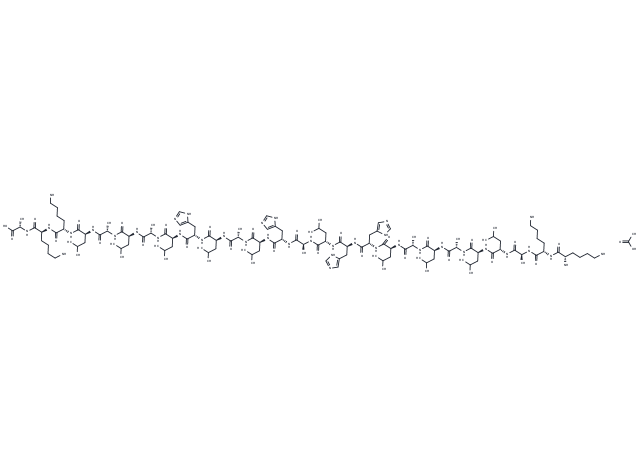Shopping Cart
Remove All Your shopping cart is currently empty
Your shopping cart is currently empty
LAH4 acetate is the α-helical structure of the designed amphoteric peptide antibiotic, which is capable of complexing DNA, associating with the cell surface membrane and wrapped in the endosome, which is destroyed with the decrease of pH value. It has strong antibacterial, nucleic acid transfection and cell penetration activities. LAH4 acetate has high plasmid DNA transmission capacity. LAH4 acetate has a strong affinity for anions in bacterial membranes.

| Pack Size | Price | USA Warehouse | Global Warehouse | Quantity |
|---|---|---|---|---|
| 1 mg | $98 | - | In Stock | |
| 5 mg | $398 | - | In Stock | |
| 10 mg | $592 | - | In Stock | |
| 25 mg | $947 | - | In Stock | |
| 50 mg | $1,280 | - | In Stock | |
| 100 mg | $1,730 | - | In Stock |
| Description | LAH4 acetate is the α-helical structure of the designed amphoteric peptide antibiotic, which is capable of complexing DNA, associating with the cell surface membrane and wrapped in the endosome, which is destroyed with the decrease of pH value. It has strong antibacterial, nucleic acid transfection and cell penetration activities. LAH4 acetate has high plasmid DNA transmission capacity. LAH4 acetate has a strong affinity for anions in bacterial membranes. |
| In vitro | LAH4 acetate mediates the transport of functional β-galactosidase, a large tetrameric protein of about 0.5 MDa, into the cell interior[1]. At acidic pH, LAH4 has exhibited a high tendency to interact strongly with and be adsorbed on anionic membrane [2]. |
| Synonyms | LAH4 acetate(184776-51-0 Free base), KKALLALALHHLAHLALHLALALKKA acetate |
| Molecular Weight | 2839.51 |
| Formula | C134H232N38O29 |
| Smiles | OC([C@H](C)NC([C@H](CCCCN)NC([C@H](CCCCN)NC([C@H](CC(C)C)NC([C@H](C)NC([C@H](CC(C)C)NC([C@H](C)NC([C@H](CC(C)C)NC([C@H](CC1=CN=CN1)NC([C@H](CC(C)C)NC([C@H](C)NC([C@H](CC(C)C)NC([C@H](CC2=CN=CN2)NC([C@H](C)NC([C@H](CC(C)C)NC([C@H](CC3=CN=CN3)NC([C@@H](NC([C@H](CC(C)C)NC([C@H](C)NC([C@H](CC(C)C)NC([C@H](C)NC([C@H](CC(C)C)NC([C@H](CC(C)C)NC([C@H](C)NC([C@H](CCCCN)NC([C@@H](N)CCCCN)=O)=O)=O)=O)=O)=O)=O)=O)=O)CC4=CN=CN4)=O)=O)=O)=O)=O)=O)=O)=O)=O)=O)=O)=O)=O)=O)=O)=O)=O.CC(O)=O |
| Relative Density. | no data available |
| Sequence | Lys-Lys-Ala-Leu-Leu-Ala-Leu-Ala-Leu-His-His-Leu-Ala-His-Leu-Ala-Leu-His-Leu-Ala-Leu-Ala-Leu-Lys-Lys-Ala |
| Sequence Short | KKALLALALHHLAHLALHLALALKKA |
| Storage | store at low temperature,keep away from moisture | Powder: -20°C for 3 years | In solvent: -80°C for 1 year | Shipping with blue ice/Shipping at ambient temperature. |
| Size | Quantity | Unit Price | Amount | Operation |
|---|

Copyright © 2015-2026 TargetMol Chemicals Inc. All Rights Reserved.